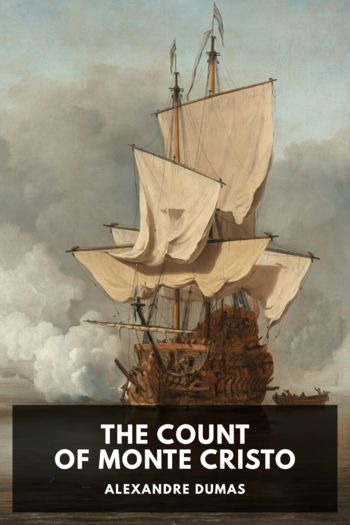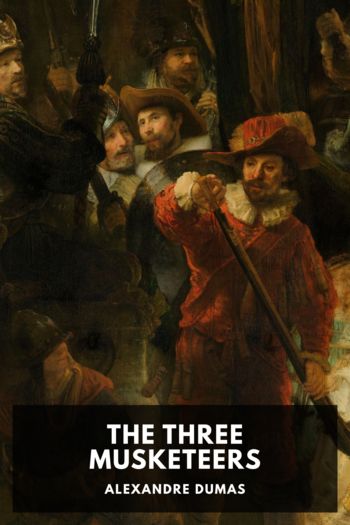The Count of Monte Cristo Alexandre Dumas (classic novels to read TXT) 📖

- Author: Alexandre Dumas
Book online «The Count of Monte Cristo Alexandre Dumas (classic novels to read TXT) 📖». Author Alexandre Dumas
“Or will you allow me to show you several fine statues by Thorwaldsen, Bartoloni, and Canova?—all foreign artists, for, as you may perceive, I think but very indifferently of our French sculptors.”
“You have a right to be unjust to them, monsieur; they are your compatriots.”
“But all this may come later, when we shall be better known to each other. For the present, I will confine myself (if perfectly agreeable to you) to introducing you to the Baroness Danglars—excuse my impatience, my dear count, but a client like you is almost like a member of the family.”
Monte Cristo bowed, in sign that he accepted the proffered honor; Danglars rang and was answered by a servant in a showy livery.
“Is the baroness at home?” inquired Danglars.
“Yes, my lord,” answered the man.
“And alone?”
“No, my lord, madame has visitors.”
“Have you any objection to meet any persons who may be with madame, or do you desire to preserve a strict incognito?”
“No, indeed,” replied Monte Cristo with a smile, “I do not arrogate to myself the right of so doing.”
“And who is with madame?—M. Debray?” inquired Danglars, with an air of indulgence and good-nature that made Monte Cristo smile, acquainted as he was with the secrets of the banker’s domestic life.
“Yes, my lord,” replied the servant, “M. Debray is with madame.”
Danglars nodded his head; then, turning to Monte Cristo, said, “M. Lucien Debray is an old friend of ours, and private secretary to the Minister of the Interior. As for my wife, I must tell you, she lowered herself by marrying me, for she belongs to one of the most ancient families in France. Her maiden name was De Servières, and her first husband was Colonel the Marquis of Nargonne.”
“I have not the honor of knowing Madame Danglars; but I have already met M. Lucien Debray.”
“Ah, indeed?” said Danglars; “and where was that?”
“At the house of M. de Morcerf.”
“Ah! you are acquainted with the young viscount, are you?”
“We were together a good deal during the Carnival at Rome.”
“True, true,” cried Danglars. “Let me see; have I not heard talk of some strange adventure with bandits or thieves hid in ruins, and of his having had a miraculous escape? I forget how, but I know he used to amuse my wife and daughter by telling them about it after his return from Italy.”
“Her ladyship is waiting to receive you, gentlemen,” said the servant, who had gone to inquire the pleasure of his mistress.
“With your permission,” said Danglars, bowing, “I will precede you, to show you the way.”
“By all means,” replied Monte Cristo; “I follow you.”
XLVII The Dappled GraysThe baron, followed by the count, traversed a long series of apartments, in which the prevailing characteristics were heavy magnificence and the gaudiness of ostentatious wealth, until he reached the boudoir of Madame Danglars—a small octagonal-shaped room, hung with pink satin, covered with white Indian muslin. The chairs were of ancient workmanship and materials; over the doors were painted sketches of shepherds and shepherdesses, after the style and manner of Boucher; and at each side pretty medallions in crayons, harmonizing well with the furnishings of this charming apartment, the only one throughout the great mansion in which any distinctive taste prevailed. The truth was, it had been entirely overlooked in the plan arranged and followed out by M. Danglars and his architect, who had been selected to aid the baron in the great work of improvement solely because he was the most fashionable and celebrated decorator of the day. The decorations of the boudoir had then been left entirely to Madame Danglars and Lucien Debray. M. Danglars, however, while possessing a great admiration for the antique, as it was understood during the time of the Directory, entertained the most sovereign contempt for the simple elegance of his wife’s favorite sitting-room, where, by the way, he was never permitted to intrude, unless, indeed, he excused his own appearance by ushering in some more agreeable visitor than himself; and even then he had rather the air and manner of a person who was himself introduced, than that of being the presenter of another, his reception being cordial or frigid, in proportion as the person who accompanied him chanced to please or displease the baroness.
Madame Danglars (who, although past the first bloom of youth, was still strikingly handsome) was now seated at the piano, a most elaborate piece of cabinet and inlaid work, while Lucien Debray, standing before a small worktable, was turning over the pages of an album.
Lucien had found time, preparatory to the count’s arrival, to relate many particulars respecting him to Madame Danglars. It will be remembered that Monte Cristo had made a lively impression on the minds of all the party assembled at the breakfast given by Albert de Morcerf; and although Debray was not in the habit of yielding to such feelings, he had never been able to shake off the powerful influence excited in his mind by the impressive look and manner of the count, consequently the description given by Lucien to the baroness bore the highly-colored tinge of his own heated imagination. Already excited by the wonderful stories related of the count by de Morcerf, it is no wonder that Madame Danglars eagerly listened to, and fully credited, all the additional circumstances detailed by Debray. This posing at the piano and over the album was only a little ruse adopted by way of precaution. A most gracious welcome and unusual smile were bestowed on M. Danglars; the count, in return for his gentlemanly bow, received a formal though graceful courtesy, while Lucien exchanged with the count a sort of distant recognition, and with Danglars a free and easy nod.
“Baroness,” said Danglars, “give me leave to present to you the Count of Monte Cristo, who has been most warmly recommended to me by my correspondents at Rome. I need but mention one fact





Comments (0)